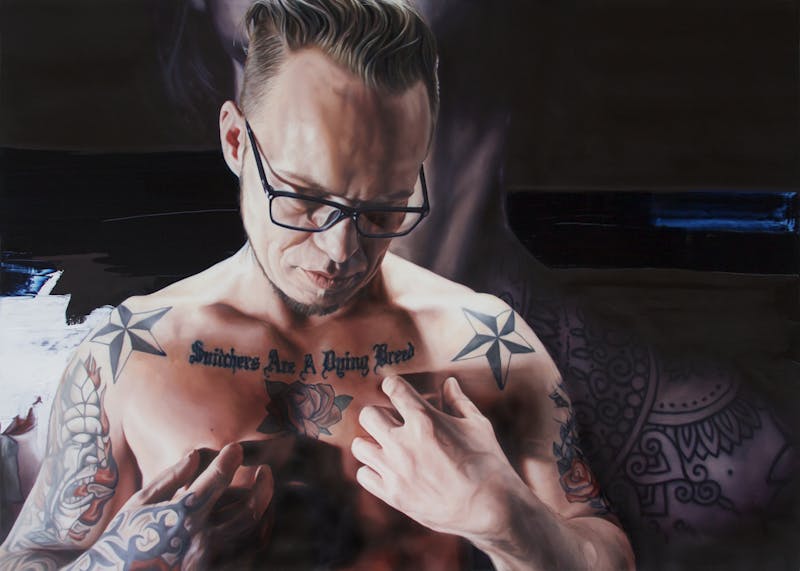A young woman stands in front of a canvas, painting a swan nestling in tall reeds. The canvas is bigger than she is, so she must travel around its surface to fill in the details. Finally, after several days, it’s finished: The Swan Song. The bird is curled up on the ground, safe in her own home, but there is a sense of danger, too—anything could come barreling through the greenery.
These are the first moments of The Painter and the Thief, a documentary by the Norwegian director Benjamin Ree. After graduating from a Special Jury Prize at Sundance to wide online streaming release in May, Ree’s film has proved a hit with viewers in search of a strong dose of raw human emotion. An unlikely film about beauty, fate, and the radical politics of forgiveness, The Painter and the Thief will restore your faith in human intimacy, no matter how battered that faith might be.
The titular painter is Barbora Kysilkova, a young Czech woman who painstakingly reproduces photographic images in oils. After grainy tape shows The Swan Song exhibited at a crowded gallery party—Kysilkova smiling, shy but thrilled—the film cuts to closed-circuit television footage of two thieves taking the painting out of its frame, rolling it up, and walking away.
Kysilkova’s paintings are worth 10,000 to 20,000 euros each, and the movie initially masquerades as a whodunnit. But we quickly learn that the titular thief is a man called Karl-Bertil Nordland. After his arrest, Kysilkova confronts him gingerly in the courtroom about the whereabouts of The Swan Song. He claims that he can’t remember where he put it, but that he took the painting because he thought that it was beautiful. Instead of pressing the matter, she asks if she can paint his portrait.
The movie then transforms from a noirish detective story into a project mapping the place where art collides with human relationships. A little mistrustful at first, Nordland agrees to sit for Kysilkova, who sketches his skinny frame as he explains how he was abandoned by his mother and got hooked on drugs, and thence to crime. Kysilkova is unwaveringly kind to Nordland, even when he’s unreliable and difficult.
When Kysilkova shows Nordland his first portrait, something truly unusual happens: Nordland’s eyes widen, the lines on his gaunt face deepen, and his mouth falls open in a wail. In shock over the proof that somebody has seen him so closely—witnessed him as he is, not as a criminal or a junkie, but as a person—Nordland breaks down in a crisis of self-recognition.

The scene is reminiscent of a passage in Ben Lerner’s Leaving the Atocha Station, in which the protagonist, Adam, witnesses another man break “suddenly into tears, convulsively catching his breath” while looking at Roger Van der Weyden’s Descent From the Cross in the Prado Museum. Adam is baffled that anyone could have such a “profound experience of art”; Ree’s movie, in contrast, is a dispatch from inside that moment of collapse. Whereas Lerner’s book is about our estrangement from beauty, other people, and, ultimately, ourselves, Nordland’s face rejects the idea that art is difficult to access or feel. Nordland’s harrowing reaction to his portrait is natural—an unmediated response to seeing himself faithfully reflected.
Ree’s documentary falls in a tradition of intensely emotional art that worries at the boundaries between artist and subject, fiction and reality. Kysilkova and Nordland are engaged in a symbiotic relationship facilitated by art. “She sees me very well,” Nordland says, “but she forgets I can see her, too.” Because of the effort and support Kysilkova pours into Nordland’s fragile well-being, he does not remain a passive subject but blossoms into a narrator in his own right. When it is Kysilkova’s turn to be vulnerable, having fallen on hard times, she shies away from intimacy with Nordland. It’s not so easy to be the subject of somebody’s gaze, it turns out.
A similar dynamic plays out between the viewer and the director of The Painter and the Thief, as plot twists confound our expectations. Over the course of his recovery, Nordland looks like a completely different person: Once a sketchy and bespectacled gangster, by the end he has a man bun and resembles a Viking hunk. This physical transformation almost makes us doubt the evidence of our eyes, giving the film an air of magic.
In an interview with Salon, Ree said that he decided to make a picture about art robberies after finishing his 2016 documentary, Magnus, about the young chess champion Magnus Carlsen. He was bored of portraying introverted people and “wanted to film people whose emotions were on the outside.” He read about the art theft in the Norwegian newspapers, and Kysilkova agreed to let him film her fourth-ever meeting with Nordland. The movie was only supposed to be 10 minutes long, but Kysilkova and Nordland were so good in front of the camera that it became a feature: “They are not self-aware,” Ree said. “They are natural and authentic.”
Between them, the painter and the thief build a third thing: a relationship, which becomes a mysterious source of creative inspiration for them both. Meanwhile, Ree continually draws attention to the process and project of filmmaking, making us aware of his artifice, though also demanding that we invest in the “natural and authentic” relationship on-screen. One leaves The Painter and the Thief feeling eager to see what might happen if we were kinder and less self-interested, and convinced anew of the basic connection between paint and the human heart.
